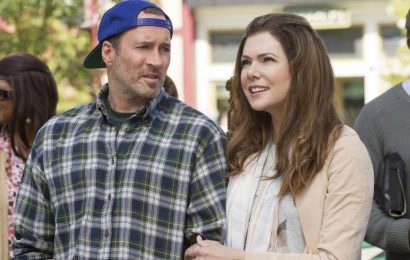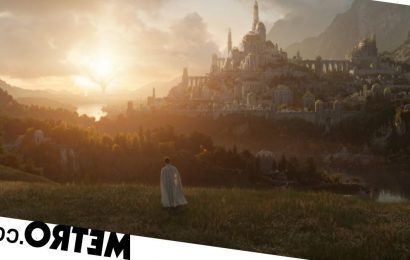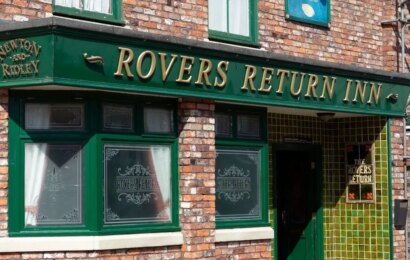Some movies don’t seem inevitable until they’re made. The most absurd thing about Sion Sono’s “Prisoners of the Ghostland” — a sukiyaki psych-Western that casts Nicolas Cage as a criminal on a mission to rescue a runaway girl from a post-apocalyptic wasteland before the bombs attached to his balls explode — is that it didn’t already exist.
This is the first film that Sono shot (predominately) in English, and the first film that Cage shot with a (predominately) Japanese crew, but “Prisoners of the Ghostland” leaves no doubt that these two wildmen speak the same language. If this gonzo cross-cultural mash-up pulls taut across more ideas than it has skin on its bones, well, it’s easy to forgive Sono and Cage for getting a bit overexcited about meeting for the first time (It may be worth noting that Sono suffered a heart attack during pre-production that scuttled plans to roll in Mexico and put the project in jeopardy until Cage suggested moving the whole thing to Japan.)
All but the most ad-hoc aspects of “Prisoners of the Ghostland” spark with the thrill of watching two completely self-possessed artists share a vision. Even when nothing else in the film makes sense, the unhinged ethos of its own creation leaves a clue behind with the clarity of a body-chalk outline. So does the movie’s title: As much as this is a story about anything, it’s about breaking the shackles of where you’re from and finding new strength from the people you meet along the way. There are perhaps too many times when that story is more compellingly told behind the camera than in front of it. But there are also other times when Cage looks screams at the sky while stretching the word “testicle” for the length of an aria.
For those unfamiliar with the poet emeritus of ero guro nansensu (lit. “erotic grotesque nonsense”), Sono emerged from the sewers of Japan’s underground cinema like an irrepressible rat king who balled up the punk energy of Oshima Nagisa, the perverse nihilism of Tsukamoto Shinya, and the renegade mayhem of Suzuki Seijun into a coherent body of work that continues to mutate in wonderfully unexpected ways. A random and reductive sample of Sono’s films might include a four-hour epic about the overlap between organized religion and upskirt photography (“Love Exposure”), a grand guignol rap opera about the gang war that erupts after a mafia don is discovered to have a micro-penis (“Tokyo Tribe”), and a romantic epic about a heartsick musician whose pet turtle evolves into a giant kaiju after he flushes it down the toilet (“Love & Peace”). In other words, collaborating with Cage — an actor you might know from his 57 years of being Nicolas Cage — could be the single most predictable thing that Sono has ever done.

Their collaboration is a meeting of the minds that immediately delivers on its orgiastic promise, as shotgun-toting outlaw Hero (Cage) bursts through the doors of a half-empty bank shouting “Banzai!” at the terrified Japanese clientele. Not very heroic at all! Making matters worse is Hero isn’t alone: He’s accompanied by his massive partner-in-crime Psycho (“The Notebook” director Nick Cassavetes), who’s doing a much better job living up to his name. Welcome to another day in the frontier city of Samurai Town, a two-horse anachronism that feels like it runs along the border between Westworld and Tokyo Disney.
The set design of Sweet Peach Street is a sight to behold, as Sono transforms a studio backlot into an electric fusion of people, cultures, and eras. There’s a cherry blossom tree on every sidewalk and a cowboy hat on every head. Classic Japanese architecture is festooned with English-language electronic tickers, the local kids pal around with a creepy Frenchman in a bolo tie, and the town’s only street appears to be a dusty cul-de-sac that ends with a massive cuckoo clock full of disembodied heads that pop out to chant ominous poetry. Is it even a clock, or just vaguely evocative of one? Who could say. Regardless, it anticipates a movie that — in its own abstruse way — is preoccupied with the stagnation of time and the oppressiveness with which it holds us in its thrall (not just in our time, but also in the time we inherit).
Samurai Town might seem to play by the rules of its own chronology, but its residents serve at the mercy of a man who’s referred to as “the greatest and most powerful clock.” That would be the Governor (Bill Moseley), a white man in an even whiter suit, and some people don’t enjoy living under the tick-tock of his watch — none more so than his adopted granddaughter Bernice (“Climax” star Sofia Boutella, always down to get weird), who hot-rods a sedan with some friends and steals away into the death-infested desert beyond. To get her back, the Governor enlists the help of the only person who might be desperate enough to go out there and get her back before it’s too late.
This is where Aaron Hendry and Reza Sixo Safai’s script really starts to wander off the beaten path. Hero is your basic terse and quippy badass with a heart of gold — imagine Nic Cage doing a slightly more loquacious Mad Max and you’ll be most of the way there — but his circumstances are… unusual. For one thing, he’s forced to wear a leather bodysuit that’s rigged with explosives and designed to “recognize the impulse of a man willing to strike a helpless woman.” For another thing… well, there really doesn’t need to be another thing when you have a time-bomb stitched to your nuts. The Governor, it seems, really doesn’t want anyone “soiling his property.” Hero has three days to get her back (tick-tock, tick-tock), and all the motivation a man could ever need.
From there, “Prisoners of the Ghostland” follows a Hero’s journey that’s been origami-ed into almost unrecognizable shape. In about five minutes flat, Hero is peeling Bernice out of a mask of cross-stitched flesh (everyone wears that in the Ghostland — it’s part of their mutant fallout chic). That leaves Sono with so much time to throw new stuff into the pot that his film starts to feel as if it’s cooking into an allegory for itself.
What follows is a hard pivot from “Escape from L.A.” to “Beyond Thunderdome” — severe even by Sono’s usual standards — as Hero is greeted by the outcasts as a savior, and soon finds himself leading a ragtag army of mutants and feral children in a rebellion against the corrupt forces of Samurai Town. It’s a battle that feels secondary to Sono’s interests; the director’s post-Fukushima work has been haunted by images of abandoned humanity and atomic decay, and “Prisoners of the Ghostland” spends large portions of the movie forcing Hero to confront the grim absurdity of life among people who’ve been left for dead on poisoned land.
The conflict between Hero and his villains is so thinly sketched that it can seem incidental, but Sono has the time of his life digging into a script that fuses American and Japanese cultures through the awful power of their shared nuclear bond. Is there a meaningful relationship between Hero and the war bride who makes him dangerously horny? There is not. Is there any sense of narrative momentum heading into the (uncharacteristically lackadaisical) climactic showdown? Not a drop.
But is there a winged “Rat Man” whose modulated voice makes him sound like a Muppet who played in toxic waste, a prophecy about a man with “thick red blood” who will be the Ghostland’s salvation, and a dramatic reading from “Wuthering Heights?” Of course there is! The film is never more surprising than when Sono deigns to fill in some of the blanks, as its one scene of unalloyed exposition is inspired by the preventative demonstrations performed outside the Hiroshima Peace Memorial every August, and moving for how it allows the ridiculousness of the Ghostland to reflect back on the horrors of our own world.
“Prisoners of the Ghostland” might lose you during some of its less emotionally lucid moments, but even in the Hero’s confusion Cage always seems to know where he is and what he’s meant to do. He’s the unstoppable engine of a weirdly sedate film that often feels like it’s running on fumes; maybe it’s just the fact that his character’s testicles are going to explode off his body if he doesn’t keep things moving, but the actor never lets us forget that the clock is ticking.
Working with a director who complements his destabilizing energy (as opposed to merely tolerating it) has become the obvious secret to unlocking Cage’s full potential, and Sono — much like “Mandy” auteur Panos Cosmatos or “Dog Eat Dog” director Paul Schrader — has the galaxy-brain vision to shoot his star so he feels like a natural expression of the movie around him. “Prisoners of the Ghostland” is a film about a fallen world that will be lost in time until it can escape the chaos of its own creation. Hero can only hope to earn his name and save his testicles if he finds a way to weaponize that chaos into freedom. Lucky for the wretches of the Ghostland, Sono and Cage have forged an alliance that shows the entire world how to do just that.
Grade: B-
“Prisoners of the Ghostland” premiered at the 2021 Sundance Film Festival. RJLE will release it in the U.S. later this year.
Source: Read Full Article







